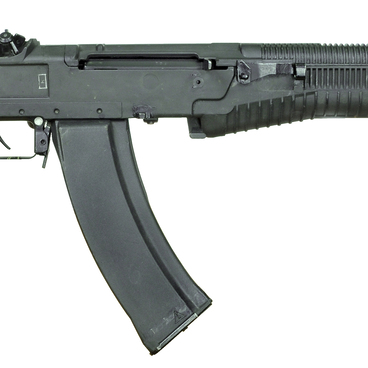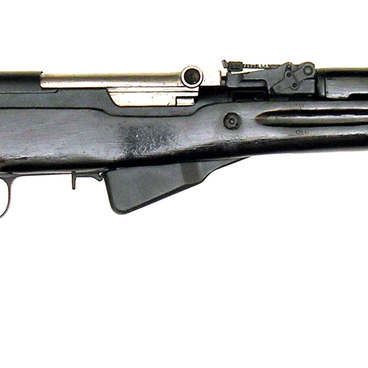This revolver was designed by Belgian industrialists Émile and Léon Nagant back in 1878. The plant in Liège, Belgium, which produced these revolvers, upgraded this weapon several times.
In 1895, Léon Nagant adopted the revolver for the Russian 7.62 mm cartridge and won a tender for supplies for the Imperial Russian army. Three years later, the Tula Arms Plant launched the production of these revolvers.
The Nagant M1895 revolver consisted of a frame with a lid, a barrel with a front sight, a ramrod tube with a ramrod, a cylinder with an axle and a return spring, a lock mechanism, a door with a spring, and a trigger guard. The novelty of the design was that the powder gases did not enter the flash gap between the barrel and the cylinder. This was achieved due to the bullet being deeply seated entirely within the cartridge case, just like a hunting cartridge. The cylinder, when the hammer was cocked, moved forward, and the muzzle of the bullet went directly into the barrel. This revolver model was distinguished by the high accuracy of fire.
During the 50 years of being used by the Imperial Army and Red Army, the revolver did not have any significant modifications. Only in 1930, the design and production technologies were slightly modified: the slot of the foresight became semicircular instead of triangular, and the front sight became semicircular-truncated.
In 1941, the Tula Arms Plant was evacuated to Izhevsk, where the production of revolvers continued. In 1942, it was partially transported from Izhevsk back to Tula. The Nagant M1895 revolver, which at that time was produced at the Izhevsk Mechanical Plant No. 622, did not differ in design from that produced in Tula, but it had a coarser cut on the wooden parts of the grip.
The Nagant revolver was used by the Red Army, including Mikhail Kalashnikov while serving in the tank forces in 1938–1940. Moreover, the NKVD troops were armed with these revolvers as well as the Polish Army, the 1st Czechoslovak Corps, the 1st Romanian Infantry Division named after Tudor Vladimirescu, the 1st Yugoslav Infantry Brigade and the French Normandie-Niemen fighter regiment.
During the Second World War, the percentage of defects in production increased due to the lack of qualified personnel. The quality of finished revolvers made in that time was also lower than in peacetime. When the revolver was used in combat, it turned out that the design of the Nagant had already been outdated. It had a low real rate of fire: the soldiers spent too much time reloading the cylinder. After the war, the Nagant M1895 revolver was no longer used in the Soviet army. Its production in Tula and Izhevsk was stopped in 1945.
In 1895, Léon Nagant adopted the revolver for the Russian 7.62 mm cartridge and won a tender for supplies for the Imperial Russian army. Three years later, the Tula Arms Plant launched the production of these revolvers.
The Nagant M1895 revolver consisted of a frame with a lid, a barrel with a front sight, a ramrod tube with a ramrod, a cylinder with an axle and a return spring, a lock mechanism, a door with a spring, and a trigger guard. The novelty of the design was that the powder gases did not enter the flash gap between the barrel and the cylinder. This was achieved due to the bullet being deeply seated entirely within the cartridge case, just like a hunting cartridge. The cylinder, when the hammer was cocked, moved forward, and the muzzle of the bullet went directly into the barrel. This revolver model was distinguished by the high accuracy of fire.
During the 50 years of being used by the Imperial Army and Red Army, the revolver did not have any significant modifications. Only in 1930, the design and production technologies were slightly modified: the slot of the foresight became semicircular instead of triangular, and the front sight became semicircular-truncated.
In 1941, the Tula Arms Plant was evacuated to Izhevsk, where the production of revolvers continued. In 1942, it was partially transported from Izhevsk back to Tula. The Nagant M1895 revolver, which at that time was produced at the Izhevsk Mechanical Plant No. 622, did not differ in design from that produced in Tula, but it had a coarser cut on the wooden parts of the grip.
The Nagant revolver was used by the Red Army, including Mikhail Kalashnikov while serving in the tank forces in 1938–1940. Moreover, the NKVD troops were armed with these revolvers as well as the Polish Army, the 1st Czechoslovak Corps, the 1st Romanian Infantry Division named after Tudor Vladimirescu, the 1st Yugoslav Infantry Brigade and the French Normandie-Niemen fighter regiment.
During the Second World War, the percentage of defects in production increased due to the lack of qualified personnel. The quality of finished revolvers made in that time was also lower than in peacetime. When the revolver was used in combat, it turned out that the design of the Nagant had already been outdated. It had a low real rate of fire: the soldiers spent too much time reloading the cylinder. After the war, the Nagant M1895 revolver was no longer used in the Soviet army. Its production in Tula and Izhevsk was stopped in 1945.

